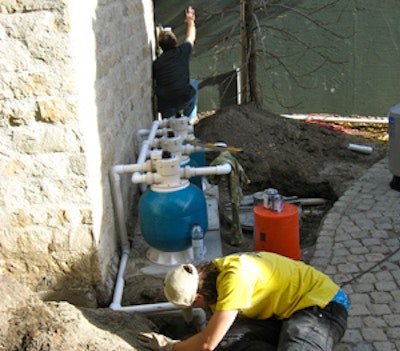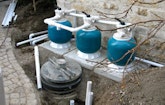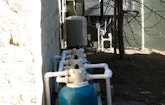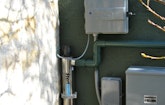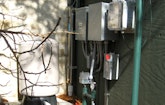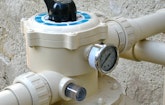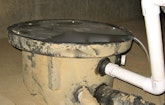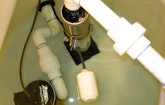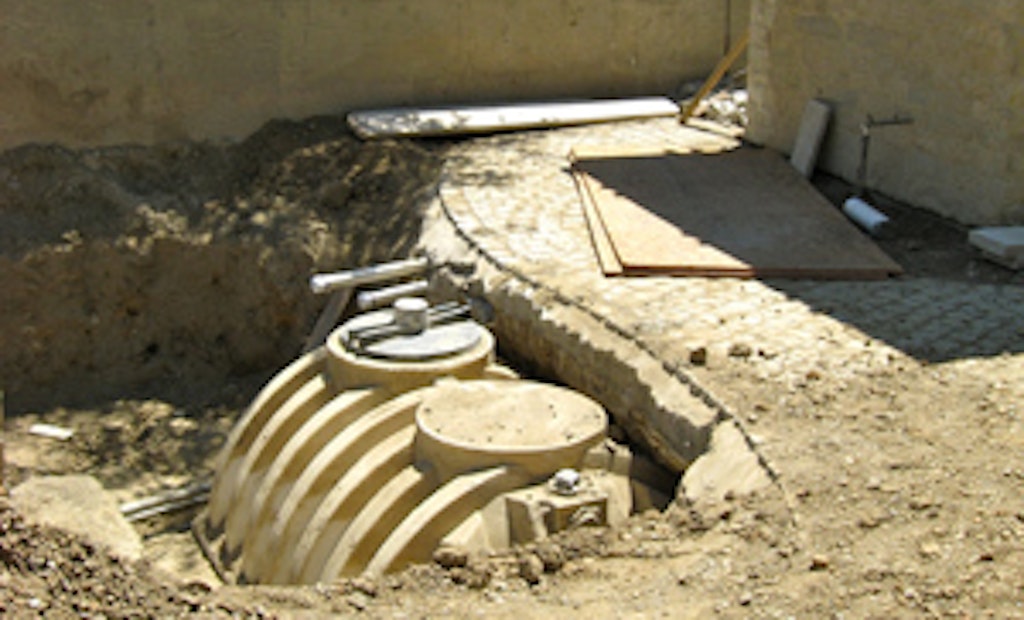
Interested in Pumps?
Get Pumps articles, news and videos right in your inbox! Sign up now.
Pumps + Get AlertsA couple wanted to build a 22,000-square-foot mansion in Brentwood, Calif., and recycle the shower, bath, and laundry water on the 3.75-acre lot. The general contractor consulted Buzz Boettcher, CEO of Water Recycling Systems in Redondo Beach.
“Finding a place for the components wasn’t exactly a challenge, but it certainly was interesting when we had to move everything from the original location,” he says.
The fully automatic high-capacity residential system uses filtration, UV disinfection and ionization to meet state Health Department Title 22 standards for bacteria content in recycled water, which is used for landscape irrigation.
System components
Boettcher sized the system based on 11 people occupying the eight bedroom suites, taking a shower upon arising and another after working out in the gym, and washing their laundry. After rounding the number, he added a safety factor of 200 gpd for a total design of 1,000 gpd. The components are:
120-gallon fiberglass sump basin. All tanks made by TOPP Industries.
1 hp effluent pump from Goulds Water Technology
Two 20-inch-diameter fiberglass filter tanks 37 inches high from Trident Filtration
18-inch-diameter fiberglass filter tank 33 inches high, Trident
Sterilight Cobalt UV system from VIQUA - a Trojan Technologies Company
Model 1200 ionization system from Carefree Clearwater
750-gallon fiberglass storage tank with 4-inch D Series Pentair Water/STA-RITE delivery pump and 1/2 hp Liberty effluent recirculation pump
19-gallon pressure tank teed to the delivery pump
GM40AVE time switch from Intermatic
Makeup water valve from The Toro Company
System operation
Graywater gravity flows from 15 sources in the house through 2-, 3- and 4-inch ABS pipe to the sump basin. On demand, the pump transfers 50 gallons to the skid-mounted filter array to treat the water.
The coarse filtration unit traps hair, soap chips, and laundry lint in a combination of gravel, silica sand, and proprietary experimental media. “Washing clothes produces a huge amount of lint that acts almost like paste,” says Boettcher.
The 5-micron filtration unit uses anthracite coal to trap remaining particles. Activated carbon in the third filter removes clothing dyes and polishes the water. Retention time through the array is one to two minutes.
Each filter has a top-mount, seven-position valve and pressure gauge. “When the pressure increases 10 psi or more above the startup level, the filter is dirty,” says Boettcher. “The backwash cycle involves flipping a lever on top of the unit, closing two valves, and flipping a switch to reverse the flow.” The water goes out the backwash drain and into the city sewer.
From the filters, treated water flows through the wall-mounted UV disinfection chamber to the anode generating copper, silver, and zinc ions. “The combination gives us a better kill rate to prevent bacterial, fungal, and algae growth while controlling odors in the charged irrigation network,” says Boettcher. “Without it, the water would stagnate in the pipes during rainy spells.”
The UV system has a lamp-life indicator that beeps when it is time to replace the bulb. The ionization system has an intensity level control that Boettcher monitored and adjusted at startup. An indicator tells when to replace the anode.
After disinfection and ionization, the water flows to the storage tank. On demand, the delivery pump sends 30 gpm to the irrigation network. A bladder inside the expansion tank expands as the pressure increases. A pressure switch automatically shuts off the pump as the delivery lines to the sprinklers reach 50 psi. The expansion tank eliminates water hammering at the beginning and end of the irrigation cycle.
When the irrigation timer opens the zone valves, the bladder contracts and pushes out the water. At 40 psi, the pressure switch activates the pump to supply water for the 20-minute irrigation cycle. After the timer turns off, the pump continues running to recharge the lines.
During periods of low flows, such as when the family goes on vacation, a makeup valve supplies water to the irrigation network. When the level in the storage tank decreases to 150 gallons, a float switch opens the valve to the municipal waterline. If the family generates more graywater than the irrigation system needs and the level in the tank reaches 675 gallons, an overflow drain sends excess to the sewer.
State Health Department code does not allow graywater to be stored for more than 48 hours. “Once in the storage tank, our product is no longer graywater,” says Boettcher. “It’s recycled, treated water, but regulators have yet to recognize the difference.”
To keep the system compliant, the recirculation pump in the tank runs for 90 minutes every 24 hours at 2 a.m., sending all the water back through the treatment train. The irrigation lines do not drain back for recycling.
Installation
Other contractors excavated tank holes and laid the underground plumbing. They set the storage tank where Boettcher indicated, close to the location for the filter array and an exterior wall. On the other side of the wall was a 5,000-pound generator bolted to the concrete foundation.
An inspector told the contractor that the generator needed three feet of clearance around it. He would have to move the wall. “That put it right on top of the storage tank,” says Boettcher. “His crew demolished the wall, ripped out the storage tank, rebuilt the wall, and moved the tank to its present location beside the footpath.”
Boettcher chose a central point under the home’s crawl space for the sump basin. “It was probably the nicest crawl space I’ve ever worked in,” he says. “The floor was concrete and I had four feet of headroom.”
The contractor had poured the floor around the excavation. To reach it and bring in supplies, Boettcher’s team used creepers to roll under the house. They padded the hole with 12 inches of gravel to raise the 48-inch-high by 36-inch-diameter basin to elevation, plumbed it, and backfilled with more gravel.
The skid-mounted 5- by 3-foot filter array arrived already plumbed. The disinfection system and electrical components came mounted on a 4-foot-square panel that attached to the wall.
“We spent a day installing the plug-and-play units,” says Boettcher. “It would have gone quicker, but just before our arrival the landscapers planted a tree where we wanted to set the filters.”
The team moved the array beside the footpath and next to the storage tank. They also connected the irrigation lines to the delivery pump via a cleanout. The system fit in an 8- by 10-foot footprint. To prevent sunlight from deteriorating the fiberglass filter tanks and Schedule 40 PVC pipes, workers covered them with UV-protective paint that matched the color of the wall.
Maintenance
The system has a one-year maintenance agreement. Boettcher visited the site weekly during startup to gauge water flow, then returned every three weeks to test the water, check the pressure on the filters, and backflush them when necessary.
